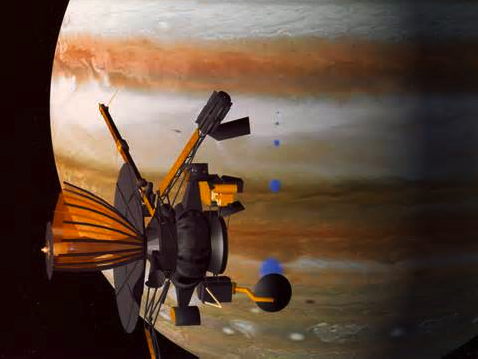
The mission utilized a VEEGA trajectory, which involved Venus-Earth-Earth gravitational assists, to reach Jupiter. The failed deployment of the Galileo High Gain Antenna required required extensive modification of plans and operations to meet mission objectives. Even with this massive handicap, the mission achieved many of its goals.
Mission Events
Launch: Oct. 18, 1989 on space shuttle Atlantis - mission STS-34Primary mission: October 1989 to December 1997
Extended missions: Three, from 1997 to 2003
Venus flyby: Feb. 10, 1990, at altitude of 16,000 km (10,000 mi)
Earth flybys: Dec. 8, 1990, at altitude of 960 km (597 mi);
Dec. 8, 1992 at altitude of 303 km (188 mi)
Asteroid Gaspra flyby: Oct. 29, 1991, at 1,601 km (1,000 mi)Comet Shoemaker-Levy 9: Impacts observed in July 1994
Asteroid Ida flyby: Aug. 28, 1993, at 2,400 km (1,400 mi)
Atmospheric probe release: July 12, 1995
Jupiter arrival and orbit insertion: Dec. 7, 1995
Probe atmospheric entry and relay: Dec. 7, 1995
34 orbits of Jupiter with flybys of moons: Amalthea - 1, Io - 7, Europa - 11, Ganymede - 8, Callisto - 8
Impacted Jupiter Sept 21, 2003
Spacecraft Description
Galileo used a dual-spin attitude stabilization system. The rotor (or spun section) turned at approximately three revolutions per minute while the stator (or despun section) maintained a fixed orientation in space. This design accommodated the different requirements of remote sensing instruments (mounted on the stator) and fields and particles instruments (mounted on the rotor); spacecraft engineering subsystems were also mounted on the rotor. The rotor and stator were connected by a spin bearing assembly, which conducted power via slip rings and data signals via rotary transformers.
There were eleven subsystems and nine scientific instruments on the orbiter. The spacecraft power source was a pair of radioisotope thermoelectric generators. Propulsion was provided by a bipropellant system of twelve 10-newton thrusters and one 400 newton engine. The command and data subsystem consisted of multiple microprocessors and a high-speed data bus. The telecommunications subsystem was designed to transmit data to Earth at rates ranging from 10 bps to a maximum of 134 kilobits per second at S-band and X-band frequencies. The rotor had one 4.8 meter high-gain antenna and two low-gain antennas, but the high-gain antenna did not deploy so data were returned from Jupiter at rates far below the design maxima using the low-gain antennas.
Mission Objectives
Jovian Atmosphere: Determine and investigate the chemical composition; structure to at least 10 bars; radiative heat balance; circulation and dynamics; nature of cloud particles.
Gaspra, Ida, and Galilean Satellites: Characterize the morphology, geology and physical state; investigate the surface mineralogy and surface distribution of minerals.
Galilean Satellites: Determine the gravitational and magnetic fields and dynamic properties; study the atmospheres, ionospheres and extended gas clouds; study the magnetospheric interactions of the satellites.
Jovian Magnetosphere: Characterize the vector magnetic fields and the energy spectra, composition and angular distribution of plasma and energetic particles, including plasma wave phenomena, out to 150 Rj.
References Helpful in Scoping the Mission
Mission DescriptionSpacecraft description
A list of pertinent references
Understanding the Instruments and Archived Data
Remote sensing instruments included:
PPR Photopolarimeter Radiometer
UVS/EUV Ultraviolet Spectrometer/Extreme Ultraviolet Spectrometer
NIMS Near-Infrared Mapping Spectrometer
SSI Solid State Imaging Camera
EPD Energetic Particles Detector
DDS Dust Detector Subsystem
PLS Plasma Detector
PWS Plasma Wave Subsystem
MAG Magnetometer
HIC Heavy Ion Counter
RSS Radio Science
POS Spacecraft Position
SSD Star Scanner
Other Useful Products for Interpreting the Data
Locating Galileo Publications
Some geometry data in "SPICE" format may be available at the NAIF node
 PDS: The Planetary Atmospheres Node
PDS: The Planetary Atmospheres Node



